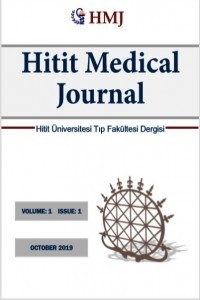Katarakt Cerrahisini Takiben Erken Dönemde Göz İçi Basınç Değişiklikleri
Fakoemülsifikasyon, Göz içi basıncı, Merkezi kornea kalınlığı
Intraocular Pressure Changes In Early Period Following Cataract Surgery
___
- 1- Vizzeri G, Weinreb RN. Cataract surgery and glaucoma. Curr Opin Ophthalmol. 2010;21:20-24.
- 2- Hildebrand GD, Wickremasinghe SS, Tranos PG, Harris ML, Little BC. Efficacy of anterior chamber in controlling early intraocular pressure spikes after uneventful phacoemulsification. J Cataract Refract Surg 2003;19:1087-1092.
- 3- Ermis SS, Ozturk F, Inan UU. Comparing the effects of travoprost and brinzolamide on intraocular pressure after phacoemulsification. Eye 2005;19:303-307.
- 4- Kurt E, Mayalı H. Early Post-Operative Complications in Cataract Surgery. In: Farhan Zaidi (Eds.), Cataract Surgery, InTech Open 2013;245-258.
- 5- Unal M, Yücel I. Effect of bimatoprost on intraocular pressure after cataract surgery. Can Journal of Ophthalmol 2008:43;712-716.6- Bomer TG, Lagreze W-DA, Funk J. Intraocular pressure rise after phacoemulsification with posterior chamber lens implantation: effect of prophylactic medication, wound closure, and surgeon’s experience. Bri Journal of Ophthalmol 1995:79;809-813.
- 7- Tanaka T, Inoue H, Kudo S, Ogawa T. Relationship between postoperative intraocular pressure elevation and residual sodium hyaluronate following phacoemulsification and aspiration. . J Cataract Refract Surg 1997:23;284-288.
- 8- Lewis RA. What is the best way to prevent and manage postoperative intraocular pressure spikes? In: Chang DF (ed). Curbside Consultation in Cataract Surgery. Thorofare, NJ, Slack, 2007; 187-189.
- 9- Tranos P, Wickremasinghe S, Hildebrand D, Asaria R, Mearza A, Nouri S et al. Same vs first postoperative day review after uncomplicated phacoemulsification. Are we overtreating early intraocular pressure spikes? J Cataract Refract Surg 2003; 29(3): 508–512.
- 10- Ahmed IK, Kranemann C, Chipman M, Malam F. Revisiting early postoperative follow-up after phacoemulsification. J Cataract Refract Surg 2002; 28(1): 100–108.
- 11- Koçak A, Anayol MA, Yülek F, Şimşek Ş. Topikal Dorzolamidin Fakoemülsifikasyon Cerrahisi Sonrasında Göz İçi Basınç Üzerine Etkinliği. Glo-Kat 2006;1:123-126.
- 12- Borazan M, Karalezli A, Akman A, Akova YA. Effect of antiglaucoma agents on postoperative intraocular pressure after cataract surgery with Viscoat. J Cataract Refract Surg 2007;33:1941-5.
- 13- Shingleton BJ, Gamell LS, O’Donoghue MW, Baylus SL, King R. Long-term changes in intraocular pressure after clear corneal phacoemulsification: Normal patients versus glaucoma suspects and glaucoma patients. J Cataract Refract Surg 1999:25;885-890.
- 14- Poley BJ, Lindstrom RL, Samuelson TW, Schulze R. Intraocular pressure reduction after phacoemulsification with intraocular lens implantation in glaucomatous and nonglaucomatous eyes Evaluation of a causal relationship between the natural lens and open-angle glaucoma: J Cataract Refract Surg 2009:35;1946-1955.
- 15- Kim KS, Kim JM, Park KH, Choi CY, Chang HR. The effect of cataract surgery on diurnal intraocular pressure fluctuation. J Glaucoma. 2009;18:399-402.
- 16- Issa SA, Pacheco J, Mahmood U, Nolan J, Beatty S.. A novel index for predicting intraocular pressure reduction following cataract surgery. Br J Ophthalmol. 2005;89:543-6.
- 17- Tranos P, Bhar G, Little B. Postoperative intraocular pressure spikes: the need to treat. Eye 2004:18;673-679.
- 18- Kasetti SR, Desai SP, Sivakumar S Sunderraj P. Preventing intraocular pressure increase after phacoemulsification and the role of perioperative apraclonidine. J Cataract Refract Surg 2002;28:2177-2180.
- 19- Alagöz G, Kükner Ş, Serin D, Çelebi S, Yalçın A. Katarakt Cerrahisinde Viskoelastik Maddeye Bağlı Yükselen Göz İçi Basıncının Düşürülmesinde Korneal İnsizyon Bölgesinden Viskoz Ön Kamara Mayisi Boşaltılmasının Etkinliği. Fırat Tıp Dergisi 2007;12(1): 44-47.
- 20- Behndig A, Lundberg B. Transient corneal edema after phacoemulsification: Comparison of 3 viscoelastic regimens. J Cataract Refract Surg 2002;28:1551–6.
- 21- Singh R, Vasavada AR, Janaswamy G. Phacoemulsification of brunescent and black cataracts. J Cataract Refract Surg 2001;27:1762–9.
- Yayın Aralığı: Yılda 3 Sayı
- Başlangıç: 2019
- Yayıncı: Hitit Üniversitesi
Katarakt Cerrahisini Takiben Erken Dönemde Göz İçi Basınç Değişiklikleri
Muhammed BATUR, Çağatay ÇAĞLAR, Habip DEMİR, Eray ESER, Tekin YAŞAR
Sertaç ARSLAN, Engin ŞENEL, Aynure ÖZTEKİN, Meral GÜLHAN, Nezahat KOŞAR, Ayşegül TAYLAN ÖZKAN
İnsizyonel Herni Gelişiminde Risk Faktörlerinin Saptanması
Murathan ERKENT, İbrahim Tayfun ŞAHİNER, Murat KENDİRCİ, Ramazan TOPÇU
Juguler Ven ve Transvers Sinüse Uzanım Gösteren Sigmoid Sinüs Trombozu
Süleyman Emre Karakurt, Öznur GÜNDÜZ, Şeyda AKBAL ÇUFALI, Hacı Hüseyin DERE
Rozasea Hastalarında Demodex Spp'nin Araştırılması
Nezahat KOŞAR, Emine SABANCILAR, Djursun KARASARTOVA, A. Semra GÜRESER, Aynure ÖZTEKİN, M. Kürşat DERİCİ, Umut GAZİ, R. Ferda ARTUZ, Ayşegül TAYLAN ÖZKAN
Rozasea Hastalarında Demodex Spp'nin Araştırılması
Nezahat KOŞAR, Emine SABANCILAR, Djursun KARASARTOVA, A. Semra GÜRESER, Aynure ÖZTEKİN, M. Kürşat DERİCİ, Umut GAZİ, R. Ferda ARTUZ, Ayşegül TAYLAN ÖZKAN
Sertaç ARSLAN, Engin ŞENEL, Aynure ÖZTEKİN, Meral GÜLHAN, Nezahat KOŞAR, Ayşegül TAYLAN ÖZKAN
